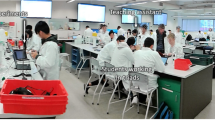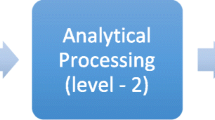Abstract
The increasing use of interactive devices and networked technologies is blurring the boundaries of the physical classroom by enabling learners and teachers to connect with digital content, systems and people located elsewhere. An underexplored opportunity enabled by emerging sensors and classroom technologies is that multimodal data traces of physical classroom activity can be automatically captured and rendered visible with the purpose of supporting teaching and learning. Positioning and proximity sensor data can be used (1) to generate a deeper understanding of embodied aspects of learning and spatial aspects of instruction, and (2) to provide evidence that enable assessment of effectiveness of the design of physical spaces in education. This chapter presents three data stories that illustrate potential emerging contributions of multimodal classroom analytics to enable new ways to study the teaching and learning processes that unfold in physical learning spaces. Through these stories, we illustrate how analytics for classroom proxemics can enable: (1) the creation of interfaces that provide feedback to learners and educators about activity in the physical classroom; (2) new ways to assess pedagogical activity in learning spaces to inform space re-design or co-configuration; and (3) new approaches to speed up analysis cycles that currently depend on classroom observations.
Access this chapter
Tax calculation will be finalised at checkout
Purchases are for personal use only
Similar content being viewed by others
References
Ahuja, K., Kim, D., Xhakaj, F., Varga, V., Xie, A., Zhang, S., …Agarwal, Y. (2019). Edusense: Practical classroom sensing at scale. Proceedings of the ACM on Interactive, Mobile, Wearable and Ubiquitous Technologies, 3(3), 1–26.
An, P., Bakker, S., Ordanovski, S., Paffen, C. L., Taconis, R., & Eggen, B. (2020). Dandelion diagram: Aggregating positioning and orientation data in the visualization of classroom proxemics. In Chi’20 extended abstracts (pp. 1–8).
An, P., Bakker, S., Ordanovski, S., Taconis, R., & Eggen, B. (2018). Classbeacons: Designing distributed visualization of teachers’ physical proximity in the classroom. In Proceedings of the International Conference on Tangible, Embedded, and Embodied Interaction (pp. 357–367). ACM.
Barnard, H. (1854). Practical illustrations of the principles of school architecture. Norton.
Bell, S. (2010). Project-based learning for the 21st century: Skills for the future. The Clearing House, 83(2), 39–43.
Bosch, N., Mills, C., Wammes, J. D., & Smilek, D. (2018). Quantifying classroom instructor dynamics with computer vision. In Proceedings of the International Conference on Artificial Intelligence in Education (pp. 30–42). Springer.
Buckingham Shum, S., & Crick, R. D. (2016). Learning analytics for 21st century competencies. Journal of Learning Analytics, 3(2), 6–21.
Cardellino, P., Araneda, C., & Alvarado, R. G. (2017). Classroom environments: an experiential analysis of the pupil–teacher visual interaction in uruguay. Learning Environments Research, 20(3), 417–431.
Chin, H. B., Mei, C. C. Y., & Taib, F. (2017). Instructional proxemics and its impact on classroom teaching and learning. International Journal of Modern Languages and Applied Linguistics, 1(1), 1–20.
Chng, E., Seyam, R., Yao, W., & Schneider, B. (2020). Examining the type and diversity of student social interactions in makerspaces using motion sensors. In Proceedings of the International Conference on Artificial Intelligence in Education (pp. 118–128). Springer.
Chua, Y. H. V., Dauwels, J., & Tan, S. C. (2019). Technologies for automated analysis of co-located, real-life, physical learning spaces: Where are we now? In Proceedings of the 9th International Conference on Learning Analytics & Knowledge (pp. 11–20). ACM. https://doi.org/10.1145/3303772.3303811
Cohen, A., Nørgård, R. T., & Mor, Y. (2020). Hybrid learning spaces—design, data, didactics. British Journal of Educational Technology, 51(4), 1039–1044.
Cook, J., Mor, Y., & Santos, P. (2020). Three cases of hybridity in learning spaces: Towards a design for a zone of possibility. British Journal of Educational Technology, 51(4), 1155–1167.
Danesi, M. (2006). Proxemics. In K. Brown (Ed.), Encyclopedia of language linguistics (2nd ed., pp. 241–243). Elsevier.
Dillenbourg, P., Zufferey, G., Alavi, H. S., Jermann, P., Do, L. H. S., Bonnard, Q., et al. (2011). Classroom orchestration: The third circle of usability. In Proceedings of the international conference on computer-supported collaborative learning (Vol. 1, pp. 510–517).
Eberts, E. H., & Lepper, M. R. (1975). Individual consistency in the proxemic behavior of preschool children. Journal of Personality and Social Psychology, 32(5), 841.
Echeverria, V., Martinez-Maldonado, R., Power, T., Hayes, C., & Shum, S. B. (2018). Where is the nurse? Towards automatically visualising meaningful team movement in healthcare education. In Proceedings of the International Conference on Artificial Intelligence in Education (pp. 74–78). Springer.
Ellis, R. A., & Goodyear, P. (2016). Models of learning space: integrating research on space, place and learning in higher education. Review of Education, 4(2), 149–191.
Fernandes, A. C., Huang, J., & Rinaldo, V. (2011). Does where a student sits really matter?-the impact of seating locations on student classroom learning. International Journal of Applied Educational Studies, 10(1), 66–77.
Fernandez Nieto, G., Martinez-Maldonado, R., Echeverria, V., Kitto, K., An, P., & Buckingham Shum, S. (2021). What can analytics for teamwork proxemics reveal about positioning dynamics in clinical simulations? Proceedings of the ACM on Human-Computer Interaction, 5, Article No. 185. https://doi.org/10.1145/3449284
Gašević, D., Zouaq, A., & Janzen, R. (2013). Choose your classmates, your GPA is at stake! the association of cross-class social ties and academic performance. American Behavioral Scientist, 57(10), 1460–1479.
Goodyear, P. (2020). Design and co-configuration for hybrid learning: Theorising the practices of learning space design. British Journal of Educational Technology, 51(4), 1045–1060.
Goodyear, P., & Carvalho, L. (2014). Framing the analysis of learning network architectures. In L. Carvalho & P. Goodyear (Eds.), The architecture of productive learning networks (pp. 48–70). Routledge.
Gunter, P. L., Shores, R. E., Jack, S. L., Rasmussen, S. K., & Flowers, J. (1995). On the move using teacher/student proximity to improve students’ behavior. Teaching Exceptional Children, 28(1), 12–14.
Hall, E. T. (1966). The hidden dimension (Vol. 609). Doubleday.
Howard, S. K., Yang, J., Ma, J., Ritz, C., Zhao, J., & Wynne, K. (2018). Using data mining and machine learning approaches to observe technology-enhanced learning. In Proceedings of the International Conference on Teaching, Assessment, and Learning for Engineering (pp. 788–793). IEEE.
Hurst, B., Wallace, R., & Nixon, S. B. (2013). The impact of social interaction on student learning. Reading Horizons: A Journal of Literacy and Language Arts, 52(4), 5.
Jones, S. E., & Aiello, J. R. (1973). Proxemic behavior of black and white first-, third-, and fifth-grade children. Journal of Personality and Social Psychology, 25(1), 21.
Koh, J. H. L., & Frick, T. W. (2009). Instructor and student classroom interactions during technology skills instruction for facilitating preservice teachers’ computer self-efficacy. Journal of Educational Computing Research, 40(2), 211–228.
Kohls, C. (2017). Hybrid learning spaces. In Proceedings of the VikingPLoP 2017 conference on pattern languages of program (pp. 1–12). ACM.
Lim, F. V., O’Halloran, K. L., & Podlasov, A. (2012). Spatial pedagogy: mapping meanings in the use of classroom space. Cambridge Journal of Education, 42(2), 235–251.
Martinez-Maldonado, R. (2019). I spent more time with that team: Making spatial pedagogy visible using positioning sensors. In Proceedings of the International Conference on Learning Analytics & Knowledge (pp. 21–25). ACM.
Martinez-Maldonado, R., Elliott, D., Axisa, C., Power, T., Echeverria, V., & Buckingham Shum, S. (2020a). Designing translucent learning analytics with teachers: an elicitation process. Interactive Learning Environments, 1–15. Routledge. https://doi.org/10.1080/10494820.2019.1710541
Martinez-Maldonado, R., Mangaroska, K., Schulte, J., Elliott, D., Axisa, C., & Buckingham Shum, S. (2020b). Where is the teacher? digital analytics for classroom proxemics. Proceedings of ACM Interactive Mobile, Wearable and Ubiquitous Technologies, 4(1), 1–27.
Martinez-Maldonado, R., Schulte, J., Echeverria, V., Gopalan, Y., & Shum, S. B. (2020c). Where is the teacher? digital analytics for classroom proxemics. Journal of Computer Assisted Learning, 36(5), 741–762.
McArthur, J. (2008). Instructional proxemics: Creating a place for space in instructional communication discourse (Phd thesis), Clemson University.
McArthur, J. (2015). Matching instructors and spaces of learning: The impact of space on behavioral, affective and cognitive learning. Journal of Learning Spaces, 4(1), 1–16.
Montague, M., & Rinaldi, C. (2001). Classroom dynamics and children at risk: A followup. Learning Disability Quarterly, 24(2), 75–83.
Neill, S., & Etheridge, R. (2008). Flexible learning spaces: The integration of pedagogy, physical design, and instructional technology. Marketing Education Review, 18(1), 47–53.
Pishtari, G., Rodríguez-Triana, M. J., Sarmiento-Márquez, E. M., Pérez-Sanagustín, M., Ruiz-Calleja, A., Santos, P., …Väljataga, T. (2020). Learning design and learning analytics in mobile and ubiquitous learning: A systematic review. British Journal of Educational Technology, 51(4), 1078–1100.
Raca, M., Kidzinski, L., & Dillenbourg, P. (2015). Translating head motion into attention-towards processing of student’s body-language. In Proceedings of the International Conference on Educational Data Mining (pp. 320–326).
Reh, S., Rabenstein, K., & Fritzsche, B. (2011). Learning spaces without boundaries? territories, power and how schools regulate learning. Social & Cultural Geography, 12(01), 83–98.
Riquelme, F., Noel, R., Cornide-Reyes, H., Geldes, G., Cechinel, C., Miranda, D.,…Munoz, R. (2020). Where are you? exploring micro-location in indoor learning environments. IEEE Access, 8, 125776–125785.
Ryser, L., Halseth, G., & Thien, D. (2009). Strategies and intervening factors influencing student social interaction and experiential learning in an interdisciplinary research team. Research in Higher Education, 50(3), 248–267.
Saquib, N., Bose, A., George, D., & Kamvar, S. (2018). Sensei: Sensing educational interaction. Proceedings of the ACM on Interactive, Mobile, Wearable and Ubiquitous Technologies, 1(4), 1–27.
Singh, V., & Thurman, A. (2019). How many ways can we define online learning? a systematic literature review of definitions of online learning (1988–2018). American Journal of Distance Education, 33(4), 289–306.
Sørensen, E. (2009). The materiality of learning: Technology and knowledge in educational practice. Cambridge University Press.
Waber, B., Magnolfi, J., & Lindsay, G. (2014). Workspaces that move people. Harvard Business Review, 92(10), 68–77.
Wake, J., Heimsæter, F., Bjørgen, E., Wasson, B., & Hansen, C. (2018). Supporting firefighter training by visualising indoor positioning, motion detection, and time use: A multimodal approach. In Lasi-nordic 2018, volume 1601. (pp. 87–90). CEUR Workshop Proceedings.
Watanabe, E., Ozeki, T., & Kohama, T. (2018). Analysis of interactions between lecturers and students. In Proceedings of the International Conference on Learning Analytics and Knowledge (pp. 370–374). ACM.
Acknowledgements
Roberto Martinez-Maldonado’s research is partly funded by Jacobs Foundation.
Author information
Authors and Affiliations
Corresponding author
Editor information
Editors and Affiliations
Rights and permissions
Copyright information
© 2022 The Author(s), under exclusive license to Springer Nature Switzerland AG
About this chapter
Cite this chapter
Martínez-Maldonado, R., Yan, L., Deppeler, J., Phillips, M., Gašević, D. (2022). Classroom Analytics: Telling Stories About Learning Spaces Using Sensor Data. In: Gil, E., Mor, Y., Dimitriadis, Y., Köppe, C. (eds) Hybrid Learning Spaces. Understanding Teaching-Learning Practice. Springer, Cham. https://doi.org/10.1007/978-3-030-88520-5_11
Download citation
DOI: https://doi.org/10.1007/978-3-030-88520-5_11
Published:
Publisher Name: Springer, Cham
Print ISBN: 978-3-030-88519-9
Online ISBN: 978-3-030-88520-5
eBook Packages: EducationEducation (R0)




